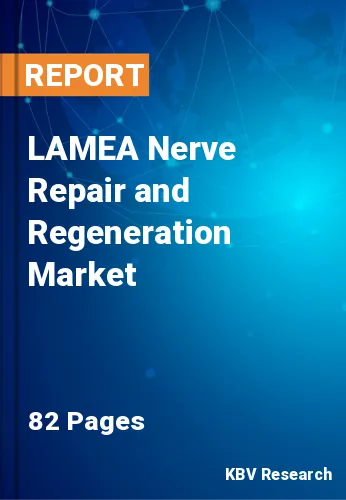The Latin America, Middle East and Africa Nerve Repair and Regeneration Market would witness market growth of 8.8% CAGR during the forecast period (2022-2028).
Collateral sprouting occurs when just portion of the axons feeding a muscle are injured, and the intact motor axons form sprouts which reinnervate the denervated muscle fibre. As early as 4 days after the injury, these nerve sprouts emerge from the nodes of Ranvier (nodal sprouts) or the nerve terminals (terminal sprouts). Collateral innervation raises the length of the surviving motor units and boosts contractile force by using denervated muscle fibres. From the moment of injury, clinical healing owing to collateral sprouting takes 3–6 months. Even though the muscle as a whole atrophies, compensatory growth of muscle fibres which have retained their axons occurs throughout this time. Improved motor unit firing synchronisation contributes to increased strength.
In opposition to partial or mild nerve injury, where the surviving motor axon initiates collateral sprouting practically instantly, neuronal regeneration begins from the proximal stump just after wallerian degeneration is finished in severe or total injury. Neuronal regrowth relies heavily on Schwann cells. They enhance the migration of nerve sprouts that grow at the regenerated axon tip by dedifferentiating and upregulating the production of adhesion molecules and neurotrophins. Those sprouts subsequently create cords that are oriented around the myelinated axons' initial basal lamina tubes, providing a conduit for new axons to grow. At around 3 months, axon regeneration overlaps with collateral sprouting, but from 6 to 24 months following the damage, axon regeneration is the primary repair strategy, based in particular on the distance the nerve must travel to reach its target muscle.
Dementia is a common disorder in Arab countries, with prevalence rates ranging from 1.1 percent to 2.3 percent among people aged 50 and up, and between 13.5 percent and 18.5 percent among people aged 80 and above, according to studies. These results, however, are similar to those of many other countries around the world. Furthermore, prevalence was seen to differ based on sociodemographic factors. Diabetes mellitus, Obesity, and cardiovascular risk factors are all major dementia risk factors, as are hypertension, low income, and a lack of education. Despite the expanding body of knowledge about the epidemiological distribution and drivers of dementia around the world, studies from the Arab world are few.
According to the WHO, the average growth rate of the ageing population (85 years and older) in various Arab nations would rise by 5% between 2000 and 2050. As a result, age disparities between groups sometimes result in variable prevalence estimates, making it impossible to compare them effectively. A substantial influence is also played by vascular risk factors and hereditary variables. Dementia is more common in the elderly than in people between the ages of 20 and 50. Thus, due to these factors, the regional nerve repair and regeneration market would witness a surge over the forecast period.
The Brazil market dominated the LAMEA Nerve Repair and Regeneration Market by Country in 2021, and would continue to be a dominant market till 2028; thereby, achieving a market value of $137 Million by 2028. The Argentina market is estimated to grow at a CAGR of 9.4% during (2022 - 2028). Additionally, The UAE market would witness a CAGR of 8.5% during (2022 - 2028).
Based on Surgery, the market is segmented into Neuromodulation Surgery, Direct Neuropathy, Nerve Grafting, and Stem Cell Therapy. Based on Product, the market is segmented into Neuromodulation Surgery Devices and Biomaterials. Based on countries, the market is segmented into Brazil, Argentina, UAE, Saudi Arabia, South Africa, Nigeria, and Rest of LAMEA.
Free Valuable Insights: The Global Nerve Repair and Regeneration Market is Predict to reach $9.4 Billion by 2028, at a CAGR of 6.4%
The market research report covers the analysis of key stake holders of the market. Key companies profiled in the report include Abbott Laboratories, Boston Scientific Corporation, Integra Lifesciences Corporation, Medtronic PLC, Axogen, Inc., Stryker Corporation, Checkpoint Surgical, Inc., Polyganics BV, Synovis Micro Companies Alliance, Inc. (Baxter International, Inc.), and OrthoMed, Inc.
By Surgery
By Product
By Country
Our team of dedicated experts can provide you with attractive expansion opportunities for your business.

